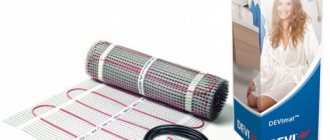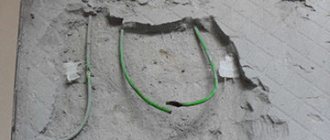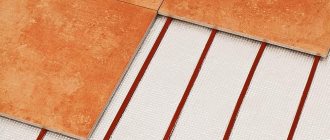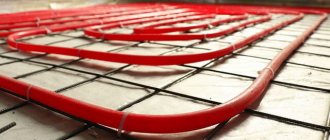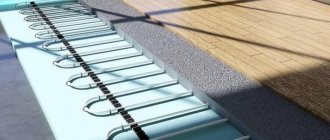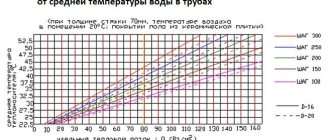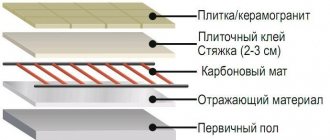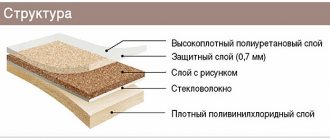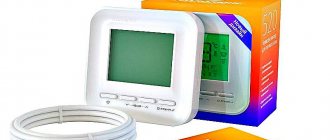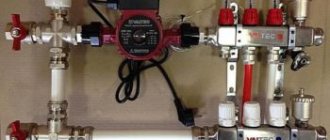Why do you need a thermal insulation substrate?
The substrate is a heat-insulating material that works like a “thermos”, and a waterproofing layer that protects against moisture. It is located between the base and the coolant, thereby softening the pressure that is exerted on the base. The main task of the substrate is to retain and transfer thermal energy upward, and not allow heat to escape into the floor.
The quality of heating is influenced by a well-equipped lining. The operation of the most powerful and expensive heating system will be ineffective if the insulation is incorrectly chosen, because the heat will be wasted.
Please note : according to technology, a heated floor system must transfer heat to at least 80% of the floor surface.
To achieve this result, it is necessary to use a heat-insulating material with low thermal conductivity in this layer of the cake. This quality allows you to reflect heat and direct it upward. That is, the underfloor heating, which is hidden under a concrete screed or located in the middle of the structure, is a key factor in effective heating.
Choosing a good substrate is not easy; you should pay attention to its practicality and manufacturability, it must be easy to use and have the necessary rigidity. Such a product will not be cheap, but it will last a long time and significantly increase the efficiency of the floor.
You can determine the best substrate by the presence of:
- good hydro- and thermal insulation properties;
- increased reflective properties;
- resistance to temperature changes, if it can withstand heating up to 90 degrees;
- resistance to deformation;
- fire resistance.
In addition, it must be environmentally friendly.
Types of substrates
The underfloor heating is a flexible flooring that is located between the floor slab and the heating element. The substrate has a number of functions:
- waterproofing - protects the heating element from moisture penetrating from below;
- thermal insulation - prevents heat penetration downwards;
- distributes heat evenly if the heating elements are located at some distance from each other. Thanks to the substrate, heat is distributed evenly over the entire surface;
- removes heat from heating elements, preventing overheating;
- performs a small soundproofing function;
- evens out minor unevenness in the subfloor.
Since the substrate has several purposes, it must meet certain requirements:
- be moisture resistant, that is, not fail if water gets on it;
- be elastic and withstand the pressure of the coating and the weight of the contents of the room;
- be tough and not crumble under pressure;
- be resistant to fungal mold and bacteria.
We recommend: How to install heated floors under PVC?
Substrates are:
- mineral;
- natural;
- synthetic;
Mineral types of substrate include fiberglass. It is a rolled material made of fiberglass. Fiberglass does not get wet, does not burn, but has minimal thermal insulation. Used as a contour between the water-heated floor and the coating.
Natural types include cork, jute, and felt substrates. These are easy to use, environmentally friendly materials.

Without special impregnation, they are quickly exposed to destructive biological influences, that is, they become infected with fungus and bacteria, which significantly reduces their service life.
The above types of materials are used as a substrate between the screed and the floor covering, for example, under laminate.
Main characteristics
- In order to understand what type of underlay you need, you must know what the underlay is for in heated floor systems.
- So, the underlayment must first of all have excellent thermal insulation and waterproofing properties. It should increase the efficiency of the heating system.
- An important property of the substrate is its ability to reflect thermal rays.
- The substrate must withstand temperature changes, working in close contact with the heating elements.
- Also, the substrate should not allow water vapor formed during heating to pass through.
- An excellent additional property of the substrate will be sound insulation.
A high-quality substrate is easy to install, has increased resistance to deformation and is environmentally friendly.
Rolled underfloor heating
This photo shows a rolled underfloor heating substrate, which is equipped with an additional reflective layer with a characteristic metallic sheen.
Features of installing a substrate under a laminate board on a warm floor
One of the most sensitive finishing flooring materials is laminated board. It is made of wood, and, as a result, it has all the characteristics of a wooden board, which has both its advantages and disadvantages. When laying laminate flooring on a heated floor, the use of an underlay is a prerequisite.
In addition to preventing heat damage to the laminate flooring, the laminate underlay also serves as a sound insulator, preventing the finished flooring from being too loud. The minimum thickness of the laminate floor board substrate on a heated floor must be at least 3 millimeters. During operation, such a substrate becomes somewhat compacted without losing its insulating properties.
Step-by-step algorithm for laying a substrate under a laminate board on a heated floor
Let's consider the procedure for laying a foam polyethylene backing under a laminate board on a heated floor.
First of all, you need to clear out your workspace. To do this, you can use a regular broom or vacuum cleaner.
Cleaning up the workspace
Then we lay the rolled backing on the cleaned surface.
Place the roll backing on the cleaned surface
The spread substrate can be secured with double-sided tape, after which you can proceed directly to laying the laminate boards.
We fix the substrate and proceed to laying the laminate
Underlay for heated floors with liquid coolant
For any design of heated floors, the substrate must serve to increase the heat transfer of the heating elements. If you use a liquid coolant - that is, you are constructing warm water floors - your substrate can additionally perform the functions of waterproofing the surface.
When installing heated water floors, you can use a substrate that will additionally serve as the basis for installing the coolant piping system. Such a substrate has special protrusions, in the spaces between which the pipeline system is mounted.
Underlay for pipes for heated floors
As a rule, such a substrate is made of polystyrene foam. One type of substrate for a warm water floor is shown in the photograph.
It must be remembered that a good substrate will be based on foil. If your substrate does not have a foil layer, then it makes sense to place a separate thin foil material on the floor, and then a heat-insulating substrate.
Polyethylene foam backing
The underfloor heating substrate, obtained by foaming polyethylene with hydrocarbons, is perfect for it. Many owners choose it because of its low price.
The main positive properties of foamed polyethylene foam substrate are excellent antistatic properties and moisture resistance. It also has good sound insulation properties.

The service life of foamed polyethylene foam is quite long, so you can be sure that such a floor will not need repairs any time soon. Thanks to this substrate, rapid and high-quality heat transfer into the room is ensured. In stores you may find unusual foam underfloor heating, the foil surface of which helps to reflect even more heat.
The scope of application of foamed polyethylene foam is quite wide; it can even be used as a substrate for warm water floors. The disadvantage of this material is its inability to withstand high temperatures for a long time. Therefore, for example, a water floor can only be used for a limited amount of time. This drawback forces buyers to pay attention to other types of substrates.
The structure of the film floor “pie”
An infrared heated floor is a multi-layer “pie” in which each layer performs an important task. It consists of:
- The base must be smooth and clean; if there are cracks and unevenness, they should be sealed with special mixtures. If the defects are significant, then it is necessary to fill in the rough screed, after laying down the waterproofing.
- Aluminum foil (reflector) - spread on the subfloor. This is a mandatory layer; it forms a shielded surface that reflects infrared radiation.
- Fiberboard or magnesite slabs - insulation. To connect the slabs to each other, a bitumen film or special tape is used.
- Infrared film - heating element.
- Flooring for the final coating - it should be selected based on the type of flooring product. The choice of thickness depends on the quality of the floors - on their evenness.
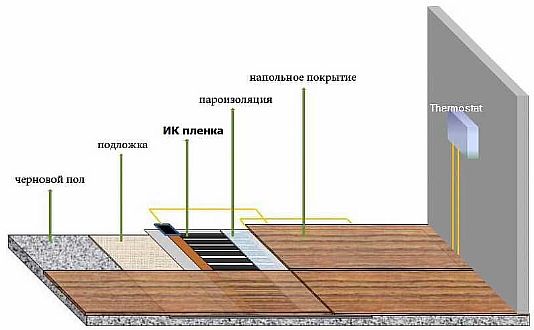
Which substrate is better to choose and why?
There are a large number of products on the modern market that are used as reflective underfloor heating.
When choosing a substrate for a film floor, you should not be guided only by savings; you need to build on the technical features, characteristics of the room and the material. Let's look at the most effective and safe types.
Extruded polystyrene foam
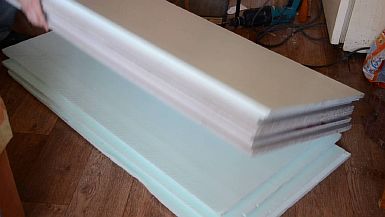
The structure of extruded polystyrene foam is evenly spaced closed cells. The material has a low density and a high degree of moisture resistance.
It does not bend, so it is often used as a backing for laminate flooring. In addition, it has great strength and good thermal insulation properties.
The product is produced in rolls and sheets. The IR film spreads directly onto this substrate.
Lavsan
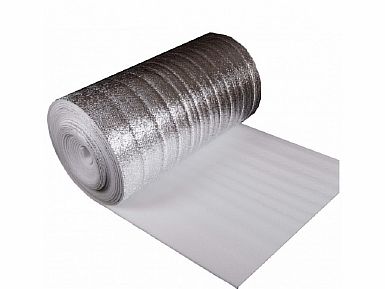
The substrate is made of foamed polyethylene with a lavsan metallized layer - the product is resistant to aggressive chemicals and microorganisms.
Lavsan flooring is laid under the film, thereby minimizing energy loss, increasing the efficiency of the floor, and ultimately leading to cost savings.
This type of reflective substrate is most suitable for infrared floors. It has a certain power density. Therefore, when choosing a lavsan bedding, the floor covering that is planned to be laid on a heated floor is taken into account.
Cork
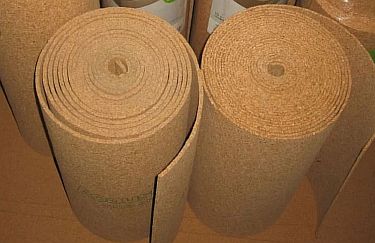
Cork is a natural material made from crushed and compressed tree bark. The product is environmentally friendly and safe for health. It's not cheap, but it will last a long time. Available in rolls or sheets.
In addition, cork is resistant to deformation (it can take its original shape), has good heat and sound insulation, and is easy to install. The main disadvantage of cork bedding is its sensitivity to moisture. But this drawback is important to take into account when arranging water floors, and for infrared systems, cork is quite a suitable material.
Self-adhesive backing
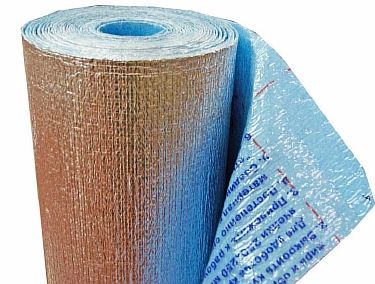
The self-adhesive backing is equipped with a heat-reflecting foil layer on one side, and an adhesive layer on the other, with which the product is attached to the concrete base. The material is ideal for use on uneven and non-standard surfaces.
The advantages of these linings are high sound and waterproofing, and ease of installation, due to the ability of the product to be self-adhesive (no additional fixation is required).
Selection of materials for waterproofing underfloor heating
The selected floor waterproofing in a private house or apartment must meet the following parameters:
- heat resistance;
- the absence of components harmful to humans that will be released into the air when heated;
- waterproofness, which is especially important when waterproofing a heated floor with coolant;
- durability.
Let's consider the most effective materials that are used to insulate an electric or water floor.
Roll waterproofing
Rolled waterproofing is the most common material, especially when installing an electric floor. The simplest option is roofing felt or thick plastic film. In recent years, waterproofing membranes have become in great demand; the material is stronger and more durable than the usual roofing felt.
Fixation is carried out by gluing or fusing using a gas torch or a hair dryer.
Before laying the rolled product, the base is carefully leveled and treated with a primer. Next, a layer of waterproofing is laid, which in its own way provides some additional insulation. Only after fixing the insulation can you begin installing the heated floor.
Coating waterproofing
The simplest type of waterproofing that can be done under a warm water floor is to apply a coating composition to the concrete base, which makes the structure resistant to moisture. In this case, it is not recommended to use mixtures made on a bitumen basis. It is better to give preference to cement-polymer compositions, applied to the surface using a roller or spatula, at the joints, laying a special tape. An equally effective product is a cast silicone mixture, which, when hardened, forms a strong and elastic membrane, which is very important when shrinking buildings that have recently been put into operation.
The mastic is applied with a brush or roller in several layers. You can also use the airless spraying method. The components of the composition penetrate into the structure of the building material, creating a protective hydrophobic layer. As a rule, waterproofing mastics are used in bathrooms, toilets and kitchens; if we are talking about a room on the ground floor, then insulation will also be a mandatory procedure.
What does saving on insulation lead to?
For example, let's take a room with an area of 50 square meters.
Usually they use polystyrene foam with bosses, the cost is 1 sq. meter on average 600 rubles, thickness - 2 cm. In most cases, this thickness is not enough for insulation, with the exception of the southern regions. Additional insulation up to 4 cm will cost another 150 rubles per square meter. The total amount will be 7,500 rubles. Saving this amount is what we are talking about when choosing insulation. The owner of the house strives to cut costs and often chooses the cheapest option - underlayment for heated floors, instead of the insulation itself. Ultimately, the thrifty home owner heats the outdoors and spends even more money to maintain a comfortable indoor temperature.
Calculation of the cost of water heated floors
We have two rooms in front of us:
- the first with normal, high-quality insulation of the required thickness;
- the second - with a substrate for a warm floor under insulation and a “thrifty” owner.
| Characteristic | House No. 1 | House No. 2 |
| Floor area | 50 | 50 |
| Pipe temperature | 40 | 40 |
| Pipe diameter | 16 | 16 |
| Insulation | 60 | 20 |
| Heat flow upward | 73,76 | 65,81 |
| Heat flow down | 18,88 | 58,72 |
| Maximum floor temperature | 26,82 | 26,18 |
In the first house, with 4 cm of insulation, the heat flow into the room exceeds the heat flow down three times. All the heat that the owner of the house pays for is used to heat the room, not the street! In the house of a “frugal” owner, the heat flow upward (to the room that needs to be heated) is almost equal to the heat flow downward (to the street, to nowhere). Forty watts per square meter go down the drain.
- On 1 square meter with underfloor heating we lose 40 W, on 50 square meters - 2000 W.
- 1 cubic meter of natural gas provides 10 kW of thermal power and costs 4.5 rubles (the price depends on the region, from 4 to 8 rubles).
- 10 00 W/2000 W = 5 hours – this is how much 1 cubic meter of natural gas is enough for heat loss.
- The boiler operates on average 12 hours a day. 12/5=2.4 cubic meters of gas are spent per day on heating the street.
- 2.4 (cubic meters) x 4.5 (rubles) x 30 (days) x 7 (months of the heating period) = 2,268 rubles per year.
They paid 7,500 rubles for the insulation / 2,268 rubles = 3.3 years - the payback period for the insulation. When using underfloor heating, heat losses will increase! These materials are not insulation!
DO NOT USE UNDERWARMING FLOOR INSTEAD OF INSULATION!
When using insulation materials with insufficient thickness for complete thermal insulation or when using foil insulation, isoline (they are also a substrate for a heated floor), the owner of the house loses a lot of heat in the lower direction. This is either unreasonable savings or a serious misconception of the homeowner. Heat losses in this case are comparable to the heat flow entering the room. The use of high-quality insulation of the required thickness pays off in an average of 3-3.5 years of operation of a heated floor, when using natural gas as an energy source. Natural gas is the cheapest source of energy. If we talk about other sources, then insulation can pay for itself in 1 heating period (i.e. in 7 months).
Which heated floors are better for tiles?
For additional heating equipment, there are several options that can be used under porcelain stoneware or ceramic tiles:
- Electrical (cable) system.
- Infrared (film) heated floors.
- Warm water floor.
To say with one hundred percent certainty: “Which warm floors are better for tiles?” It is necessary to answer several questions related to the installation and operating conditions of the structure. Namely: “Main or auxiliary heating?”, “Will a screed be installed, and what is its permissible maximum height relative to the height of the room?”, “What kind of existing heating is it: autonomous or centralized?” The answers to these questions will help you make your choice.
Features of choosing a substrate
You need to choose the substrate carefully, since not only the operation of the heated floor, but also the atmosphere in your home depends on it. Therefore, when purchasing insulation, professionals advise paying attention to the following points and making a choice based on the parameters listed below.
Video
By type of heated floor
It is necessary that the substrate meets the requirements laid down by the heating system manufacturers:
- Water floor - for this design, a foil backing with a reflective coating is used. This mat is inexpensive and is great if you want to save living space, but the type is not recommended for basement floors. For water floors, it is better to take film models; although they are more expensive, they are equipped with increased thermal properties. An excellent solution for a water structure is an extruded foam substrate with bosses; it has improved quality and ease of installation, since the pipes are laid in grooves. Choosing rolled cork or expanded polystyrene would also be a good option.
- Electric floor - foil roll or tile insulation is suitable. The presence of an aluminum reflective layer is not recommended; it is better if it is vacuum deposition. If the height allows for a thicker cake, then it is worth putting polystyrene foam with a foil layer 2 - 3 cm thick. If height is limited, polyethylene foam 2 - 3 mm can be used as thermal insulation.
Water heated floor
Works on water heating pipes laid between the ceiling and the flooring. Water is heated in a boiler or boiler and supplied through the heating circuit using a pump.
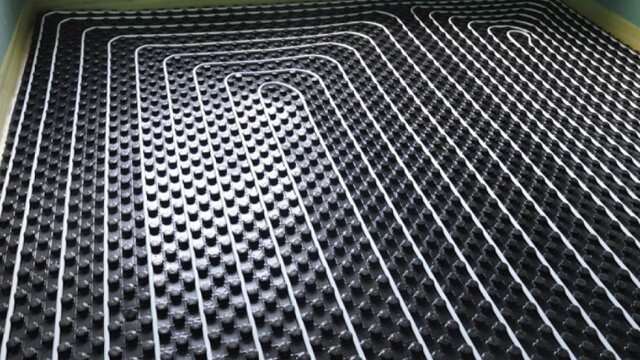
The cooled water goes back into the boiler and so on in a closed cycle. The built-in heat control system will not allow the floor to heat up above the set temperature.
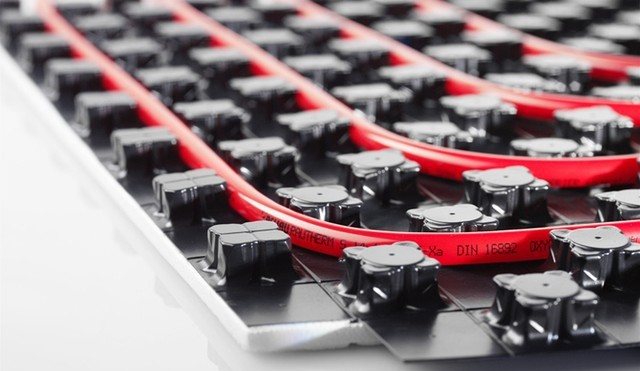
This type of heated floor is good for individual housing, but is completely unsuitable for an apartment building with central heating. Another disadvantage is that if a pipe breaks or leaks, it is often necessary to dismantle the entire structure.
We recommend: How to connect a heated floor?
Underlay for laminate
Currently, laminate is almost the most popular floor covering: it has a reasonable price, looks very similar to parquet, and its installation is very simple. If you plan to install heating under the laminate, you must make sure that a lining is installed under the heated floor system, which will help protect the wood from overheating. Otherwise, gaps will form in areas of the floor with a gap between the laminate and the base, and the coating itself will knock heavily.
To avoid such problems, a special thin (2-5 mm) part is placed under the laminate, which has increased thermal conductivity.
This move will not only avoid damage to the boards, but will also act as insulation, equalize possible height differences and prevent the laminate from squeaking. This backing is usually foil and is placed under a heated floor, where, in addition to its function of leveling the laminate, it also helps to retain heat.
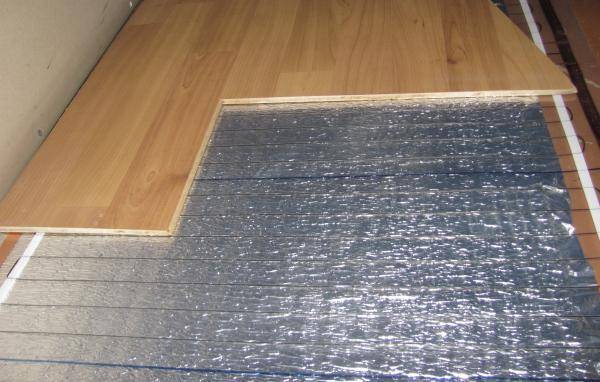
Foil backing for laminate.
This component is mounted between the heating elements and the laminate. Manufacturers of wood flooring themselves advise using roll-type polyethylene for lining. A substrate made of this material combines well with concrete and cement and is poorly exposed to chemical compounds and living organisms. But in addition to compatibility with the finishing floor covering, the underlay must combine well with the selected type of heated floor, which will be discussed further.
Features of installing a substrate under a laminate board on a warm floor
One of the most sensitive finishing flooring materials is laminated board. It is made of wood, and, as a result, it has all the characteristics of a wooden board, which has both its advantages and disadvantages. When laying laminate flooring on a heated floor, the use of an underlay is a prerequisite.
In addition to preventing heat damage to the laminate flooring, the laminate underlay also serves as a sound insulator, preventing the finished flooring from being too loud. The minimum thickness of the laminate floor board substrate on a heated floor must be at least 3 millimeters. During operation, such a substrate becomes somewhat compacted without losing its insulating properties.
Under a warm water floor
Water-based heated floors are quite popular due to their cost-effectiveness and ease of installation. When using a water heated floor system, you must take care in advance of the presence of a special layer. It is made of polystyrene foam; a little less often you can find linings made of cork or isoplat.
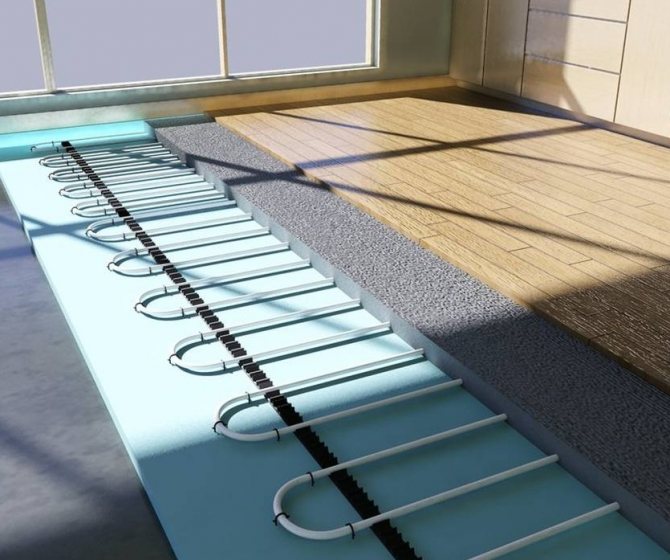
The correct underfloor heating will ensure that warm air rises upward, thereby making the structure work optimally. Thanks to the high technologies used in production, polystyrene foam substrates have many advantages:
- Provide additional heat and sound insulation;
- Practically do not absorb moisture, are fireproof;
- They help retain heat, which means they are economical and environmentally friendly;
- Maintain structure and integrity even with sudden temperature changes;
- Very durable - the minimum service life is 100 years.
Cork backing
This material is chosen by lovers of all things natural. Cork underfloor heating is obtained by pressing wood particles glued together with suberin. As a result, the output material is able to withstand temperature shocks and the release of various vapors.
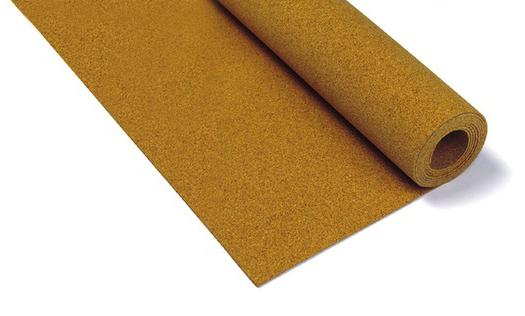
Cork is most often used as a substrate for warm water floors. The high price justifies the excellent performance characteristics of the cork.
Laying technology: secrets of specialists
Follow the following list of work stages when laying the infrared film underfloor heating:
- Prepare a hole for the thermostat.
- Provide power to your system by choosing a convenient outlet.
- Carry out thermal insulation work. Use reflective insulation. Correctly calculate the thickness of the lavsan substrate layer under the infrared heated floor, it should be within 3-5 mm.
- When laying insulation, fasten it with mounting tape and direct the film towards the wall with a thermostat, this way you will significantly reduce the size of the wire.
- Maintain a distance of 10-20 cm near the walls. If there are installed heaters, such as a fireplace, stand back at least 1 meter.
- Lay the substrate evenly under the infrared heated floor under the laminate, watch the density of the material. If you do everything correctly, the approximate value will be 150g/m2.
- Lay the film carefully along the joints.
- Use IR film systems to heat floors with underlays.
- Cut the coating only in bright areas.
- Tape the joint edges and outer sides with tape.
- Insulate the ends of the film, stick on bitumen insulation.
- Place the wires in the thermal insulation of the covering.
Carry out professional work taking into account the type of heating system and the selected material of the heat-reflecting substrate.
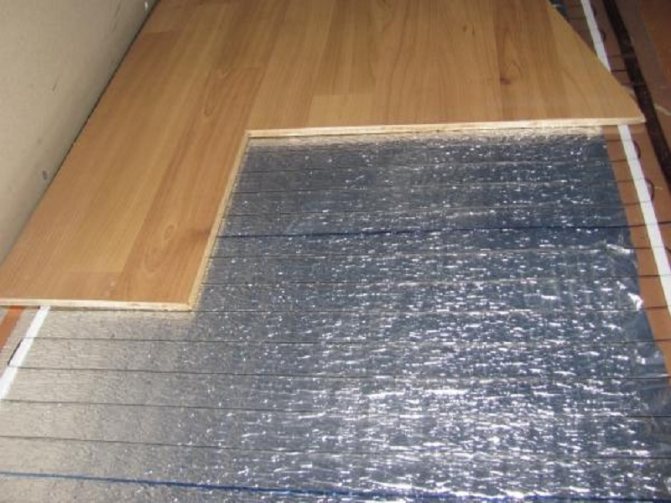
Order a consultation with a specialist for the correct selection and installation of the substrate for film heated floors: infrared, electric, water. Call or leave a request on the website.
Let's take a closer look at some types of synthetic substrates
- cross-linked polypropylene foam. It consists of sheets with a thickness of 2 to 20 mm. It has sufficient rigidity and elasticity so as not to deform under pressure. It has excellent thermal insulation and sound insulation characteristics. Due to its resistance to heat, it is used as an insulator for building heating elements and as a substrate for infrared and film heated floors. But it is not without drawbacks - it is highly flammable;
- extruded polystyrene foam. Plates with thickness from 5 to 200 mm. It has the lowest thermal conductivity properties among similar products, is resistant to chemical influences, resistant to mold and bacteria, has high compressive strength, and is also not afraid of moisture. It is considered one of the most environmentally friendly materials among synthetic types of insulation. Many experts consider this material optimal and recommend using it as a substrate when installing both water and electric heated floors. However, the material is not without drawbacks - without fire retardant impregnation it has flammable properties. Not all brands of this material are resistant to chemical solvents;
- foil underfloor heating (isolon, folgoizol, polyethylene foam). Inexpensive lightweight material, thickness from 10 to 50 mm. It is a foamed synthetic roll material with many closed pores on one side and covered with foil on the other side. It is resistant to fungi and bacteria, and is not afraid of water, like all synthetic materials. Moderately flammable. However, it has a significant drawback: it does not have much elasticity and quickly collapses under pressure, which reduces its service life to several months. Experts do not recommend using this material as floor insulation;
- polystyrene foam boards with bosses. 20mm or more thick. They come with or without a thin polystyrene coating. Designed for water floors, but recently they have also been used for electric floors. Convex elements (bosses) are needed to fix water pipes or other heating elements between them. During installation, the bosses may break; the heating element is poorly fixed between them without additional fasteners. Therefore, it is more advisable to use coated slabs. In this case, you can walk on them; no additional fixation is needed. This type of insulation has good thermal insulation properties, does not rot, does not wrinkle, and absorbs sound well.
We recommend: How to install heated flooring under laminate on a concrete floor?
Regardless of which underfloor heating the customer chooses, it must meet modern requirements: be environmentally friendly, durable and perform the functions assigned to it.
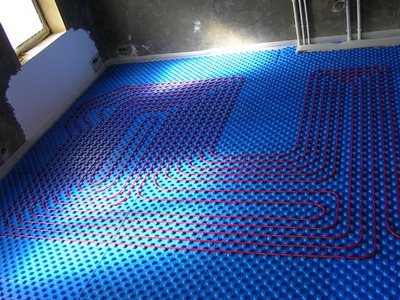
- Related Posts
- What kind of warm floor can be laid under a carpet?
- Is it possible to use underfloor heating as the main heating?
- How to turn on the heated floor?
- How to lay Ononor heated flooring?
- How to install Eastec heated flooring?
- How to connect a warm water floor in a house from a gas boiler?
